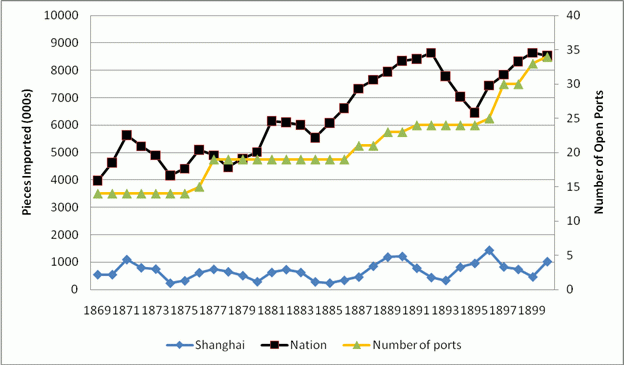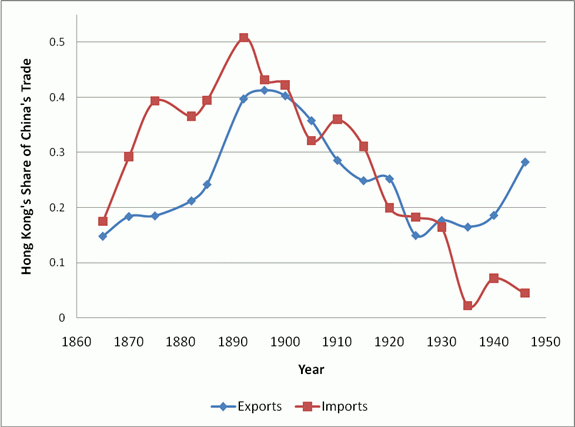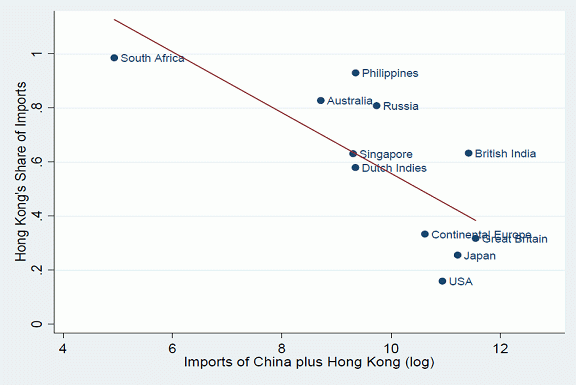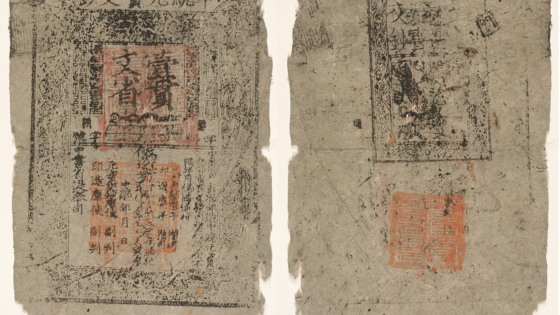Talk about market access restrictions. Until the year 1840, China’s international trade was limited to only a handful of local firms in a single port, Canton (Guangzhou). That did not sit well with Western countries who wanted to import more and more silk and porcelain from China in exchange for Western goods. Trade liberalisation came swiftly in the form of British gunboats. After defeat in the Opium War (1840-42), China was forced to open its economy to foreign trade at a large number of so-called treaty ports. Soon after, China’s foreign trade started growing rapidly. By the 1920s, China’s share in world trade reached a level so high that it was topped only in the 1990s, after China’s foreign trade had taken off again.
Nineteenth century China is the ideal setting to study a number of central issues in trade and development, as we discuss below. There is, first, the anatomy of the gains from trade for a country. Second, it gives a lens for studying intermediation, an important channel through which foreign trade works. And third, we can investigate the long-run impact of trade liberalisation in the context of colonisation
The anatomy of gains from trade
The gains from foreign trade arise because it gives domestic consumers access to goods at lower cost than under autarky. Trade is a powerful mechanism that can transform entire countries (Acemoglu et al. 2005). At the same time, in the early phase of trade opening, foreign goods are available to only a small share of the country’s population. Take “Grey Cotton Shirtings and Sheetings”, which was a major 19th century cotton piece good. It was new to China at the time, and importing it might have had large welfare gains associated with them (Feenstra 1994, Broda and Weinstein 2006). Along these lines, Hersh and Voth (2009) have found significant welfare gains from sugar, coffee, and tea consumption in England for the 1700s and 1800s.
While typically very little is known on how new goods spread throughout the country, here it is observed very clearly. Figure 1 shows the number of these piece goods imported to China in 1869 were around 4 million (left axis), of which about 20% were accounted for by Shanghai, China’s dominant city. China’s imports increased to around 9 million by the end of the 19th century. Importantly, this was entirely due to additional regions of China having access these imported cotton goods, and not by increased consumption in the Shanghai area. As Figure 1 shows, while Shanghai’s imports are flat the increase in imports is largely accounted for by the increase in the number of open treaty ports. At the same time, we find that in Shanghai it is not the volume of this particular type of cotton piece good that increased but rather the number of different cotton goods varieties almost tripled.
Figure 1. Nineteenth century Chinese trade
Two aspects of the anatomy of the gains from trade become clear.
- First, there is increased availability of foreign goods throughout China, as opposed to only more goods in the Shanghai area. This matters because the marginal utility from new goods in additional regions of an importing country will be higher the more imports there are in an established importing area.
- Second, there is a leader-follower relationship in the sense that new goods are first imported in Shanghai, much like in a test market (perhaps due to local demand more than any port advantages), before new goods diffuse throughout the country. This emphasises that the gains from trade manifest themselves only over time.
Trade intermediation
China’s trade opening after the Opium War also confirms that Hong Kong’s role as entrepôt for China’s trade goes way back. Figure 2 presents the share of Hong Kong in China’s exports and imports between the years 1865 and 1946 (from our research Keller et al. 2010). It is clear that the importance of Hong Kong was far from constant over time. The broad pattern is one of rising shares of both imports and exports during the last 35 years of the 19th century before both shares decline from then on. With around 50% of China’s trade going through Hong Kong in the 1990s (Feenstra and Hanson 2004), this implies huge swings for the role of Hong Kong as China’s trade intermediary.
Figure 2. Hong Kong’s share of China’s trade
One explanation for these swings may be that establishing international trade links between buyers and sellers requires paying a fixed cost to acquire knowledge specific to a market (recent work includes Rauch and Watson 2004, Blum et al. 2009, Ahn et al. 2010).
Did this matter for China? The answer is yes. In fact, Western exporters were initially surprised to not be able to sell large quantities of knives, forks, and pianofortes in 19th century China (Keller et al. 2010). Trade intermediation through Hong Kong emerges because it is not optimal for exporters to acquire market-specific knowledge individually. Along these lines, the decline in trade intermediation for the years 1895 to 1935 is explained by dynamic learning effects of selling in China. Moreover, the fixed-cost argument suggests for the cross-section that large exporters are more likely to cover the fixed costs than small exporters. This is confirmed in Figure 3, which shows that Hong Kong’s share in China’s imports was falling in the volume of trade around the year 1900: countries that export relatively little to China and Hong Kong, such as Australia or the Philippines, tended to ship through Hong Kong whereas big traders such as Great Britain or Japan exported directly to China.
Figure 3. Entrepot trade through Hong Kong is declining in size
The impact of colonialism
The third issue is the impact of trade liberalisation in the context of colonial invasion. These are outside pressures that go beyond your typical IMF- (or EU-) administered rescue loan package. What was the effect on China? Foreign trade, for one, increased both in absolute and in relative terms; China’s foreign trade rose from next to nothing to about 2% of world trade by the 1920s. One may expect that China would cap this trade as soon as it truly became master of its own affairs – and it did for a while after World War II, together with many less developed countries. Today, however, China is one of the countries in the world most open to foreign trade by a number of measures. For example, China’s export-to-GDP ratio is comparable to Denmark’s, which is remarkable given that there are roughly 250 Chinese for every 1 Dane in the world.
The fact that it is possible to study the 19th century opening of China at all is due to the information gathering of the Chinese Maritime Customs (CMC) service, an organisation set up and run by Western countries on behalf of the Chinese foreign office. The CMC revolutionised China’s customs system by introducing transparent rules and customs procedures in place of discretion and corruption, which strongly raised net tariff revenues. The CMC recorded not only foreign but also domestic trade, as well as steamer traffic. The CMC was also involved in the fighting pirates, the dredging of harbours, the building of lighthouses, and the postal system. It was instrumental in bringing institutional as well as technological change to China during this period.
As we discuss in Keller et al. (2010), China’s role in world trade today is shaped in part by the post-1978 market reforms and in part by foreign trade several centuries ago. While trade was officially suppressed or supported it was present throughout China’s history. In the late 18th century, the performance of China’s commodity markets was comparable to Western Europe’s, with the exception of England (Shiue and Keller 2007). The Western invasion in the 19th century greatly expanded foreign trade, which brought new goods and ideas to China. Steamships ploughed up the Yang-tze river to Hankow (Wuhan) and further upriver. The opening of the Suez-Canal (1869) and the telegraph (1871) changed the way business was done in China – and none of this would have happened without China’s opening under pressure in the 1840s. Like it or not, the legacy of the opening of China by force in the 19th century are being felt today.
References
Acemoglu, Daron, Simon Johnson, and James Robinson, 2005, “The Rise of Europe: Atlantic Trade, Institutional Change, and Economic Growth”, American Economic Review 95(3), 546-579.
Ahn, JaeBin, Amit Khandewal, and Shang-Jin Wei, 2010, “The Role of Intermediaries in Facilitating Trade”, NBER Working Paper 15706.
Blum, Bernardo, Sebastian Claro, and Ignatius Horstmann, 2009, “Intermediation and the Nature of Trade Costs: Theory and Evidence”, working paper
Broda, Christian and Weinstein, David E. 2006. “Globalisation and the Gains from Variety”, Quarterly Journal of Economics 121(2): 541-585.
Feenstra, Robert C.; Hanson, Gordon H. 2004. “Intermediaries in Entrepôt trade, Hong Kong re-exports of Chinese goods”, Journal of Economics & Management Strategy, March, Vol. 13 Issue 1, p. 3-35.
Hersh, Jonathan, and Hans‐Joachim Voth. 2009. “Sweet Diversity: Colonial Goods and the Rise of European Living Standards after 1492”, Working Paper, Wharton School.
Keller, Wolfgang; Li, Ben and Shiue, Carol H. 2010. “China’s Foreign Trade: Perspectives From the Past 150 Years.” CEPR Discussion Paper 8118.
Shiue, Carol H., and Wolfgang Keller, 2007, “Markets in China and Europe on the Eve of the Industrial Revolution”, American Economic Review 97(4), 1189-1216.
Rauch, James, and Joel Watson, 2004, “Network Intermediaries in International Trade”, Journal of Economics and Management Strategy, 13(1): 69-83.








